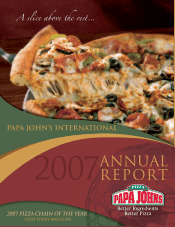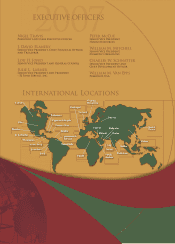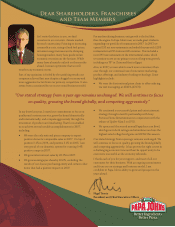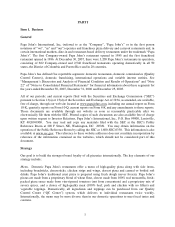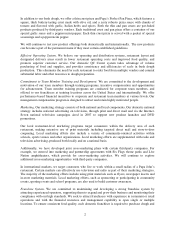Papa Johns 2007 Annual Report Download - page 11
Download and view the complete annual report
Please find page 11 of the 2007 Papa Johns annual report below. You can navigate through the pages in the report by either clicking on the pages listed below, or by using the keyword search tool below to find specific information within the annual report.4
strategy, the Company purchased franchised restaurants in an under-penetrated or emerging domestic
market with the intention of building additional Company-owned restaurants to increase market
awareness. During 2007 and 2006, we acquired restaurants with a total purchase price of $52.0 million
for a variety of reasons including implementing the previously mentioned buy and build strategy,
opportunities to purchase restaurants in markets where we have a significant Company-owned restaurant
presence and opportunities to expand in growing metropolitan areas.
The Company plans to implement a formal refranchising initiative during 2008, the goal of which is to
increase the percentage of franchised units in the domestic restaurant portfolio over time. The Company
believes shifting the domestic restaurant portfolio mix more toward franchised units will improve the
absolute level and consistency of operating margin percentage and be more consistent with the trend in
franchise business models in the domestic restaurant category. Of the total 2,760 domestic units open as
of December 30, 2007, 648 or 23.5% were Company-owned (including 128 units owned in joint venture
arrangements with franchisees in which the Company has a majority ownership position). The Company
believes that through a combination of net openings more heavily weighted toward franchise units and
the selective refranchising of certain Company-owned markets, the percentage of Company-owned units
can be decreased below 20% over the next few years. Any such unit sales completed during 2008 are not
expected to have a significant impact on 2008 operating income.
Internationally, we own and operate six restaurants in the United Kingdom and eight in Beijing, China.
During 2008, we plan to add five Company-owned restaurants in the United Kingdom and five Company-
owned restaurants in China.
Restaurant Design and Site Selection
Backlit awnings, neon window designs and other visible signage characterize the exterior of most Papa
John’s restaurants. A typical domestic Papa John’s restaurant averages 1,100 to 1,500 square feet. Papa
John’s restaurants are designed to facilitate a smooth flow of food orders through the restaurant. The
layout includes specific areas for order taking, pizza preparation and routing, resulting in simplified
operations, lower training and labor costs, increased efficiency and improved consistency and quality of
food products. The typical interior of a Papa John’s restaurant has a vibrant color scheme, and includes a
bright menu board, custom counters and a carryout customer area. The counters are designed to allow
customers to watch the team members slap out the dough and put sauce and toppings on pizzas.
Most of our international Papa John’s restaurants are between 900 and 1,400 square feet; however, in
order to meet certain local customer preferences, several international restaurants have been opened in
larger spaces to include dine-in and restaurant-based delivery service, with an average of 35 to 100 seats.
We will utilize dine-in service as part of our international growth strategy based on a country-by-country
evaluation of consumer preferences and trends.
We consider the location of a restaurant to be important and therefore devote significant resources to the
investigation and evaluation of potential sites. The site selection process includes a review of trade area
demographics, target population density and competitive factors. A member of our development team
inspects each potential domestic Company-owned restaurant location and substantially all franchised
restaurant locations and the surrounding market before a site is approved. Our restaurants are typically
located in strip shopping centers or freestanding buildings that provide visibility, curb appeal and
accessibility. Our restaurant design can be configured to fit a wide variety of building shapes and sizes,
which increases the number of suitable locations for our restaurants.
We provide layout and design services and recommendations for subcontractors, signage installers and
telephone systems to Papa John’s franchisees. Our franchisees can purchase complete new store

